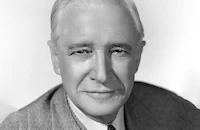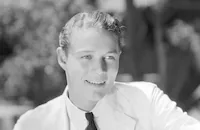Operator 13

Brief Synopsis
Cast & Crew
Richard Boleslavsky
Marion Davies
Gary Cooper
Jean Parker
Katharine Alexander
Ted Healy
Photos & Videos
Film Details
Technical Specs

Synopsis
Early in the Civil War, the Second Battle of Bull Run is a disaster for the North. At a camp show for Union soldiers, performer Gail Loveless is recruited to become a spy by her friend, Pauline Cushman, who is herself a spy known as "Operator 27." Working for agent Major Allen Pinkerton, Gail agrees to become a spy known by the code name "Operator 13." She then goes South with Pauline to the headquarters of Confederate General "Jeb" Stuart. Posing as Pauline's black maid, Gail encounters Captain Jack Gailliard, a Confederate officer, when he rides by her washing and ruins it. Jack is a spy for the South, and when Pauline asks too many questions about him at a ball that evening, he and Captain Cornelius Channing become suspicious and have her room searched. Meanwhile, a traveling medicine show run by Doctor Hitchcock, who is secretly a captain in the Northern army, arrives looking for Operators 27 and 13. Gail is able to transfer information about Confederate troop movements to Hitchcock just as Pauline is being arrested. Gail is also suspected of being a spy, but when she is brought to testify at Pauline's trial, she divulges Pauline's real identity and says that her mistress "turned Yankee." Pauline is then sentenced to death, but Gail and Hitchcock help her to escape. Back in Washington, Pinkerton knows that Pauline can no longer operate across enemy lines, so he entrusts Gail with the mission to learn more about the activities of Jack, whom Pinkerton suspects is working with "Copperheads," Southern sympathizers, who live in the North. To make herself believable, Gail, using the name "Anne Claybourne," openly jeers at marching Union soldiers. She and a man posing as her father are then "arrested." When the incident is reported in Southern newspapers, "Anne" becomes a heroine and is deported to Richmond, where she becomes the guest of Mrs. Shackleford and her daughter Eleanor. Gail also re-encounters Jack, who is attracted to her, but suspects that he has seen her before. While at the Shackleford's, Gail is able to pass on information to the North that results in an important victory, but which causes the death of Eleanor's fiancé, John Pelham, just a few hours before their wedding. Feeling guilty over her part in John's death, Gail goes into the garden to cry and is met by Jack, who tells her that he loves her. Because she has also fallen in love with him, she moves him out of the aim of one of her operatives who is spying on them from the bushes. Soon, however, she gets away from Jack and, dressed in a Confederate soldier's uniform, heads North after the operative tells her that the Confederates now know she is a spy. As Jack and Channing chase her into the woods, they split up and Jack finds Gail asleep in a spring house. He then angrily calls her a a traitor and vows to take her back for a court-martial. He handcuffs Gail, but as they leave the house, they see Union soldiers execute Channing. Gail's operative then rushes toward the soldiers, but because of his rebel uniform, he is shot. The Union soldiers then decide to search the house, but leave after finding no one. Gail and Jack, who had hidden in the spring, now escape together and, after a blacksmith files their handcuffs off, Jack heads South, while Gail tearfully goes North. A few years later, the war is finally over and Gail and Jack reunite and pledge their love to each other.

Director

Richard Boleslavsky
Cast

Marion Davies

Gary Cooper

Jean Parker

Katharine Alexander

Ted Healy
Russell Hardie

Henry Wadsworth

Douglas Dumbrille
Willard Robertson

Fuzzy Knight

Sidney Toler

Robert Mcwade

Marjorie Gateson
Wade Boteler
Walter Long
The Four Mills Brothers

Sterling Holloway

Samuel S. Hinds
Sam Mcdaniel

Hattie Mcdaniel
Francis Mcdonald
William Griffith
James Marcus
Buddy Roosevelt
Si Jenks
Frank Mcglynn Jr.

Wheeler Oakman

Don Douglas
Frank Marlowe
Reginald Barlow
Jim Marcus
Ernie Alexander
Richard Powell
Belle Daube

Wilfred Lucas
Bob Stevenson
Martin Turner
Frank Burt
Wally Howe

William Henry
Richard Tucker
Arthur Grant
Sherry Tansey
Lia Lance
Charles Lloyd

De Witt C. Jennings
Sam Ash
Ernie Adams
Clarence Hummel Wilson
Franklin Parker
Claudia Coleman
Sherry Hall

Douglas Fowley
Fred Warren
John Elliott
Frank Leighton
James C. Morton
John Larkin
Crew
Adrian
Wayne Allen
Dr. William Axt
Howard Dietz
Walter Donaldson
George Folsey
Cedric Gibbons
Arnold Gillespie
Red Golden
Eve Greene
Lucien Hubbard
Gus Kahn
Stan Lambert
Paul Marquardt
Charles Maxwell
Maurice De Packh
Zelda Sears
Douglas Shearer
Frank Sullivan
Harvey Thew
Jack Virgil
Edwin B. Willis

Photo Collections
Film Details
Technical Specs

Award Nominations
Best Cinematography
Articles
Operator 13
Like most of the vehicles Hearst crafted for Davies through his Cosmopolitan Pictures, an independent company housed on the MGM lot for ten years, Operator 13 was a lavish production. Although the story was relatively simple, about the romance between Union spy Davies and Confederate spy Gary Cooper during the Civil War, Hearst wanted to outdo The Birth of a Nation (1915) by creating a sweeping saga of the war between the states. His painstaking interference created turmoil on the production. Operator 13 had gone in front of the cameras with Raoul Walsh directing and Walter Wanger producing. But Hearst wasn't happy with their work and had Wanger taken off the film. He also demanded a revised screenplay, which sent Walsh packing. They were replaced by Lucien Hubbard as producer and Richard Boleslawsky, who had survived directing all three Barrymore siblings in Rasputin and the Empress two years earlier.
But even with the new production team, things moved slowly. Hearst was responsible for a large part of this, as he personally supervised every detail of the shoot. He even stepped in and directed some scenes himself when he didn't think Boleslawsky was getting them right. Yet, there was a positive side to this. An epic montage of Civil War battles that he had demanded was one of the sequences most often praised by the critics. And his attention to detail brought favorable comparisons to the work of D.W. Griffith.
Hearst wasn't the only person slowing things down. Although a gifted actress, particularly in comedy, Davies was never as interested in her film career as was her inamorata. As a result, she didn't exactly have the strongest work ethic in the world. Cooper would later describe a day on the set like this: "[Davies would] show up about ten, do two or three setups, and then retire to her dressing room for lunch, pretty wet and pretty long. After a nap, we'd do two or three more shots, then high tea, which was martinis, then Marion was off home. Helluva way to make a movie."
None of this got in the way of the growing friendship between Davies and Cooper - a relationship that would remain purely platonic. She admired his generosity on the set. He never quarreled when he knew that a scene needed to be thrown to her. But he also paid little attention to direction. She was amused to hear Cooper agree to suggestions from Boleslawsky (or "Boley" as she called him), then play the scene exactly as he had before. For his part, Cooper was amused by Davies' carefree character and appreciated the fact that she put him on the guest list for Hearst's West Coast retreat, San Simeon.
The real problems were taking place in the corporate offices. For years Hearst had been complaining that MGM management didn't take Davies seriously as an actress. They had never given her a push for the Academy Award and routinely gave the best parts to other actresses - usually production chief Irving G. Thalberg's wife, Norma Shearer. While Operator 13 was in production, Hearst was battling to win Davies the leading role of Elizabeth Barrett Browning in The Barretts of Wimpole Street, a prestige production adapted from the stage hit starring Katherine Cornell. When MGM announced that the role would go to Shearer, Hearst decided to move his production unit to Warner Bros.
Losing Hearst had its positive and negative aspects for MGM. On the downside, it meant losing preferential treatment in the papers he ran and the columns and radio broadcasts of his Hollywood gossip columnist, Louella Parsons. But his over-produced pictures had cost the studio dearly. The 20 films he made with Davies between 1925 and 1934 cost over $14 million altogether and had a combined loss of almost $1 million. Even with strong reviews, Operator 13 was simply too expensive to make a profit.
Moving to Warner Bros. did little to boost Davies' box-office performance. She made only four more films there and was clearly tired of film stardom. In fact, she had urged Hearst to let her retire when they left MGM. For his part, Hearst was suffering from declining health and needed to turn his attentions to his publishing empire, which had begun to feel the pinch of the Great Depression. Operator 13 was the last of Davies' films that he personally supervised.
Producer: Lucien Hubbard
Director: Richard Boleslawsky
Screenplay: Harvey Thew, Zelda Sears, Eve Greene
Based on the novel by Robert W. Chambers
Cinematography: George Folsey
Art Direction: Cedric Gibbons, Arnold Gillespie
Music: William Axt
Principal Cast: Marion Davies (Gail Loveless/Ann Claibourne), Gary Cooper (Capt. Jack Gailliard), Jean Parker (Eleanor), Katherine Alexander (Pauline Cushman), Ted Healy (Dr. Hitchcock), Douglas Dumbrille (Gen. "Jeb" Stuart), Fuzzy Knight (Sweeney), Sidney Toler (Maj. Allen), Russell Hardie (Lt. Gus Littledale), Henry Wadsworth (Capt. John Pelham).
BW-85m.
by Frank Miller

Operator 13
Quotes
Trivia
Curly Howard of the Three Stooges was originally to have appeared in this film.
Notes
Robert W. Chambers' novel was serialized in Hearst's International-Cosmopolitan, and the film credits the source as "the stories of Robert W. Chambers," rather than the novel . According to a news item in Hollywood Reporter in August 1933, Fred Niblo, Jr. and C. Gardner Sullivan were collaborating on a screenplay for Operator 13, but the extent of their participation in the completed film has not been determined. According to various news items in Daily Variety and Hollywood Reporter, production began on February 1, 1934 under Walter Wanger's supervision and Raoul Walsh's direction, with Al Shenberg working as the assistant director. On February 12, 1934, production was stopped on orders from William Randolph Hearst, the head of Cosmopolitan Pictures. A Daily Variety news item notes that all of the film shot was scrapped and a new story was written. At that time, Wanger was replaced by Lucien Hubbard, who was originally intended to produce the picture. Because Walsh protested against the new script, he was also taken off the film. The picture resumed production on February 19, 1934, under Hubbard's supervision, with Richard Boleslavsky the new director and Red Golden the new assistant director. Although the CBSC lists Jay Lloyd as "Gaston," Wade Boteler is credited with that role on the film. Variety commented, "Miss Davies is particularly effective as a colored wench, a disguise she simulates in one major chapter as the maid to Katherine Alexander. Her dialect and mannerisms are decidedly effective." For his work on the film, cinematographer George Folsey received an Academy Award nomination.














